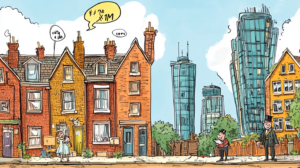The Bank of England appears poised to implement its first interest rate reduction in more than four years, should recent projections from a Reuters survey of economists hold true. The survey indicates that a strong majority anticipates the central bank will lower interest rates at its upcoming August meeting, bringing the benchmark rate down to 5% from the current 5.25%. This rate, a 15-year peak, follows an unprecedented sequence of 14 consecutive increases.

Conducted between July 18 and 24, the survey found that 49 out of 60 economists predict a rate cut. However, opinions within the market remain divided. Just over half of market participants—54%—expect rates to remain unchanged, while 46% anticipate a reduction. This split highlights the uncertain economic climate and differing interpretations of recent economic data.
Notably, sentiment has shifted from earlier in the year. A Reuters poll in June, conducted before the release of the latest inflation data, showed an overwhelming 97% of respondents expected a cut. This shift in expectations underscores the evolving nature of economic forecasts and the significant influence of new data on predictions.
Mortgage lenders have already begun adjusting in anticipation of the potential cut. Nationwide, one of the UK’s largest mortgage providers, recently introduced a sub-4% five-year fixed-rate mortgage deal, signaling that lenders are preparing for a period of lower borrowing costs.
The last time the Bank of England lowered rates was in March 2020, at the onset of the COVID-19 pandemic in the UK. Since then, rates have steadily risen in an effort to curb inflation, with the Bank aiming to bring it down to its 2% target. Despite inflation reaching this target for the past two months, the central bank has maintained rates at 5.25%, reflecting the complexity of balancing inflation control with economic stability.
Attention is now focused on the Bank of England’s meeting next week. JP Morgan economist Allan Monks suggests that the decision will be a close one: “We look for a 25 basis point rate cut at next week’s meeting, although the call appears much closer than it did several weeks back. The case for lower rates is far from clear. If rates are lowered in August, it looks likely to happen on a close 5-4 vote.” His analysis highlights the delicate balancing act facing the central bank.
In June, the Bank of England voted 7-2 to keep the rate at 5.25%, reflecting a strong preference for maintaining the status quo. However, trends in the lending market—where mortgage providers have begun reducing rates in line with swap rates—suggest growing readiness for a cut.
The economic impact of rising mortgage costs has been significant. Research from the Institute for Fiscal Studies, funded by the Joseph Rowntree Foundation, estimates that higher borrowing costs have pushed approximately 320,000 people into poverty—almost 100,000 more than official figures indicate. This discrepancy arises because official data applies a single average interest rate to all households, underestimating the number of those significantly affected. IFS research economist Sam Ray-Chaudhuri noted, “This has led to the headline statistics understating the number of people in poverty, something set to get worse in next year’s data. Poverty rises have also been understated due to the unequal impact of inflation.”
As the Bank of England prepares to make its crucial decision next week, the stakes are high. A rate cut could offer relief to borrowers but also reflects the broader economic challenge of managing inflation, growth, and financial stability.



